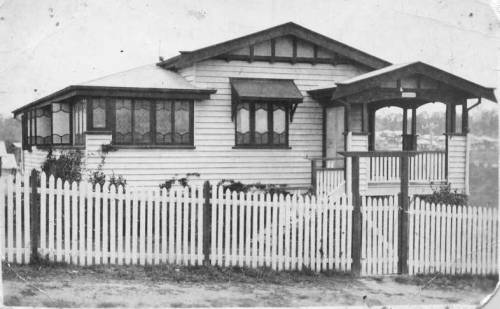I was born in a house (whose house?; rented or owned?) next door to Aunt Kate's at Graham St. in the shadow of the historic clock tower, South Brisbane. The two houses were so close together that you shake hands with people in the neighbouring house. My father could afford to have a doctor, Dr. Meek, as well as a midwife, Nurse Willis, to attend my birth. I already had a brother, John Joseph, who was born eleven months earlier. John died at his second birthday, and three months before my next brother, Kevin Edward, was born on the 6th. February, 1925.
My parents spent wisely and bought a block of land at Camp Hill where, with the assistance of the Workers' Dwellings (later the Housing Commission) finance Ted and Kate had their family home constructed. In 1925 Ted and Kate, Kate's sisters Mary and Nellie, with myself and brother Kevin moved in.
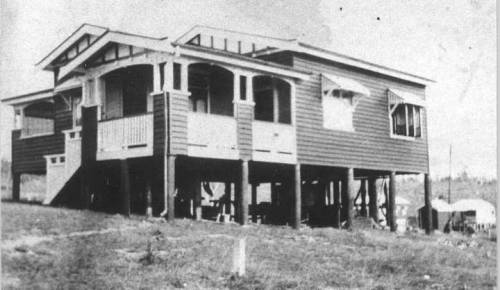
In July 1926 another brother, Lawrence Francis, was born. About this time Ted had a serious accident. He fell down the cargo hold of a ship which shattered the bone in his temple. Ted remained conscious but in great pain. He kept appealing to the attendants, "For Christ's, don't let Katie know!!". It was a credit to the surgeons that they so successfully repaired his skull with a non-corrosive metal that, while Ted suffered from bouts of headache attributed to the accident, he lived out a pretty active four score years.
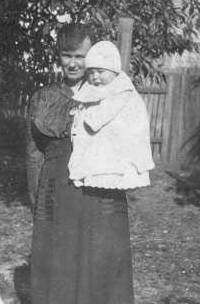 Two years after the birth of Lawrence, Ted and Kate had their first daughter Betty (born Mary Elisabeth, 31st. July, 1928). Nine days short of the year brother Leo Conrad was born (22nd. July, 1929) and just over a year later my second sister Ellen Imelda was born (15 August, 1930). In short, Kate had given birth to seven children in eight years.
Two years after the birth of Lawrence, Ted and Kate had their first daughter Betty (born Mary Elisabeth, 31st. July, 1928). Nine days short of the year brother Leo Conrad was born (22nd. July, 1929) and just over a year later my second sister Ellen Imelda was born (15 August, 1930). In short, Kate had given birth to seven children in eight years.
Ted and Kate had the front bedroom, Nellie the middle and Mary the back bedroom until her marriage to John Murray and birth of her daughter Molly in the late twenties. Ted had glassed in the long verandah which converted into a dormitory for the six children.
In the 1920s the area where my parents settled was not densely populated. Most roads were unmade, at most with a little gravel surface. Opposite in Kelsey Street was a vacant lot that became the site of the house for Mary and John Murray. On the right was the Dixon's and on the left was the Giffin's, a plumber who fathered even more kids than the Englarts. A couple of hundred metres on the left in Waverley Rd. was the Ramage's who had one son, Neil. On the right you could walk another two or three hundred metres to get to the home of the Gorring's, the parents of Neville and Eric.
It was another few hundred metres to get to the top of the hill where you found the Wallace's. To the south it was hundreds of metres to the Haughton's and the Walsh's across the creek where we caught lobbies (fresh water lobsters) with a piece of meat on a string. In short, my brothers and sisters grew up in open spaces - grass lands cleared of big trees beyond which was bush land and forest, often subject to periodic raging bush-fires. In contrast the summer monsoonal rains caused massive flooding of the low lying land to the south and west of our house.
OUR HOME
My father fenced the property, developed fruit and vegetable gardens, a poultry run and a cow shed for the two cows. He put up two 10 metre high masts to string the antenna to provide for my family to be among the first radio listeners in the country. The neighbours used to sit on the Englart's lawn while listening to this latest technological marvel - the radio.
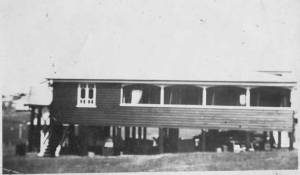
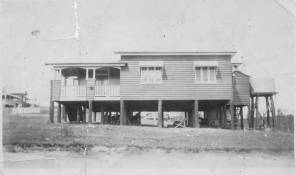
Kate cooked on fuel stove and washed the clothes by boiling in a copper in the back yard. It was difficult to dry all the nappies and children's clothes in wet weather so Ted built a network of ropes and pulleys so that Kate could pull the drying washing to the top of the very high ceiling to catch the heat off the stove.
Ted was proud of the ownership of a hot water fountain - a copper tank snugly fitted to the fire-box of the stove which provided us with two gallons of very hot water before most working class homes could boast of hot running water. It provided enough hot water to wash-up and for Katie to give the kids a wash in the kitchen sink before bed. A weekly plunge bath was reserved till Saturday afternoon when we boiled the bath water in the copper boiler in the back yard.
For the benefit of the younger generation who wouldn't be able to wash clothes without a washing machine, I will try to draw a picture of wash day when I was young. First woollens and delicate materials would be separate (Kev once put woollen socks in the boiler to have them reduced to gelatinous mess). The "copper" was a 60 cms hemispherical vessel made of hardened copper supported by a cast iron boiler about one metre high with a wood fire on a grate under the copper and with a flue to take the smoke away. After putting cheap common soap into the copper Kate would stuff the sheets and other washing into the boiling water with the aid of what was called "the stick" (a broom stick). Katie would occasionally use the stick to lift the hot washing up out of the water and let the washing fall back, so entraining air which helps the washing process.
When considered washed Katie would lift the washing out of the copper into a pine box with holes to drain the hot water into a large galvanised tub which was returned to the copper to save the hot suds. The washing was rinsed a few times in cold clean water and wrung by hand before hanging on the clothes line which consisted of a steel wire supported a forked stick that was known as a "clothes prop".
With the help of neighbours Ted built a tennis court on the easterly side of the house. They excavated to about two metres on the northerly end and built up the southerly end. The court had an ant-bed composition about 75 centimetres deep. (We were not conscious of what we were doing to the ecology in those days. The ant-bed gave us the optimum mix of silica and clay). I can remember when we puddled the wet ant-bed in our bare feet until it was smooth enough to rule off in much the same way as a concrete floor layer rules off a new floor. I understand that the Englart court was one of the best in Brisbane.
The soil at Camp Hill wasn't deep. Ted wasn't very successful as an orchardist. The citrus, mango, Queensland nuts - none did well. But one tree that grew with us was a weeping fig that benefited from it's location next to the poultry yard. By the time we reached the teens it became a locus of much pleasure for climbing and nocturnal singing of the then popular songs. I feel somewhat sorry for young people today who have lost the capacity to enjoy themselves through singing (even if lacking a fine sense of tune).
